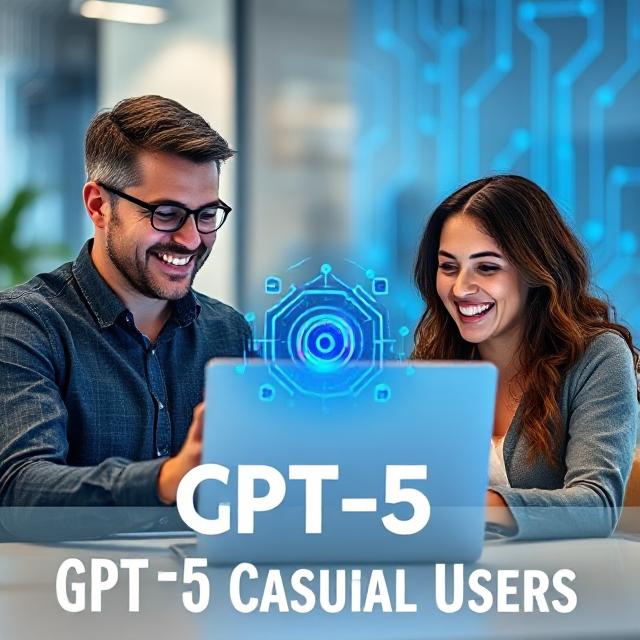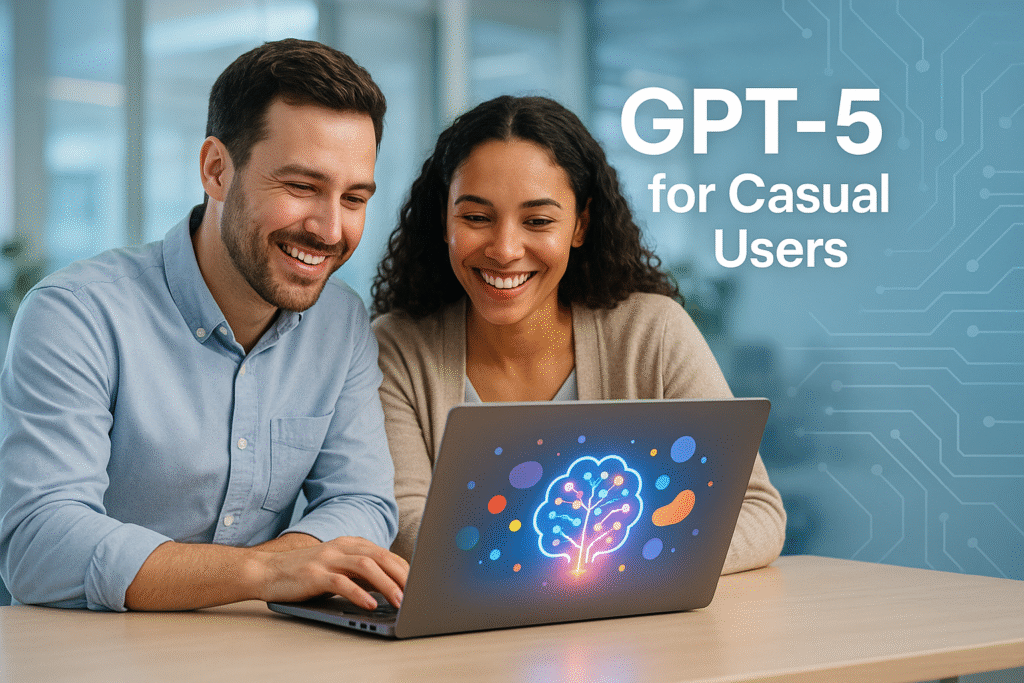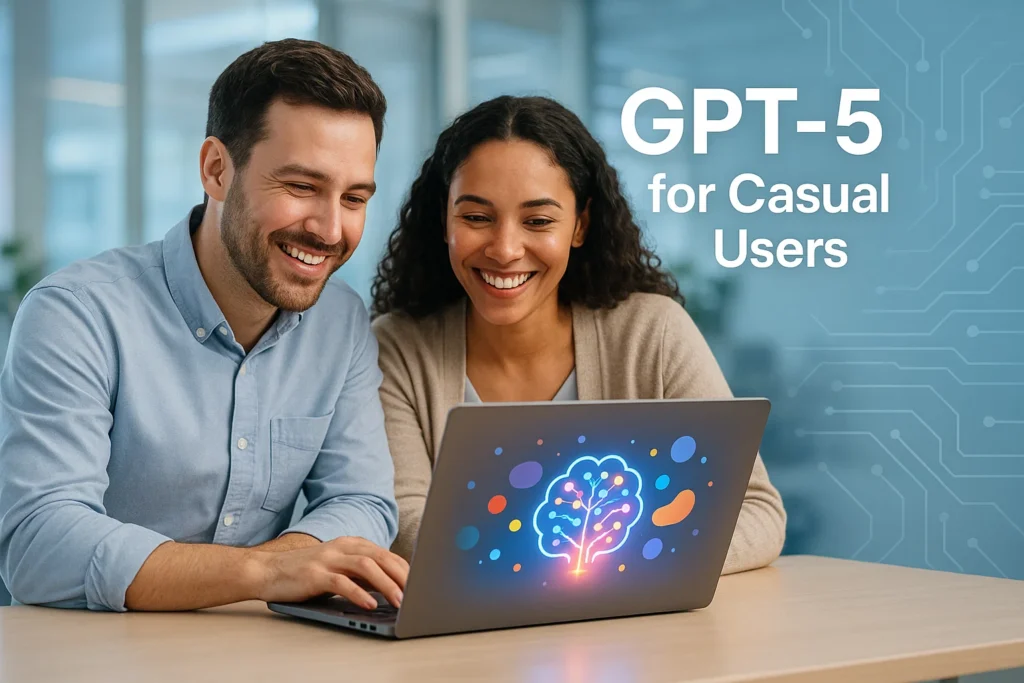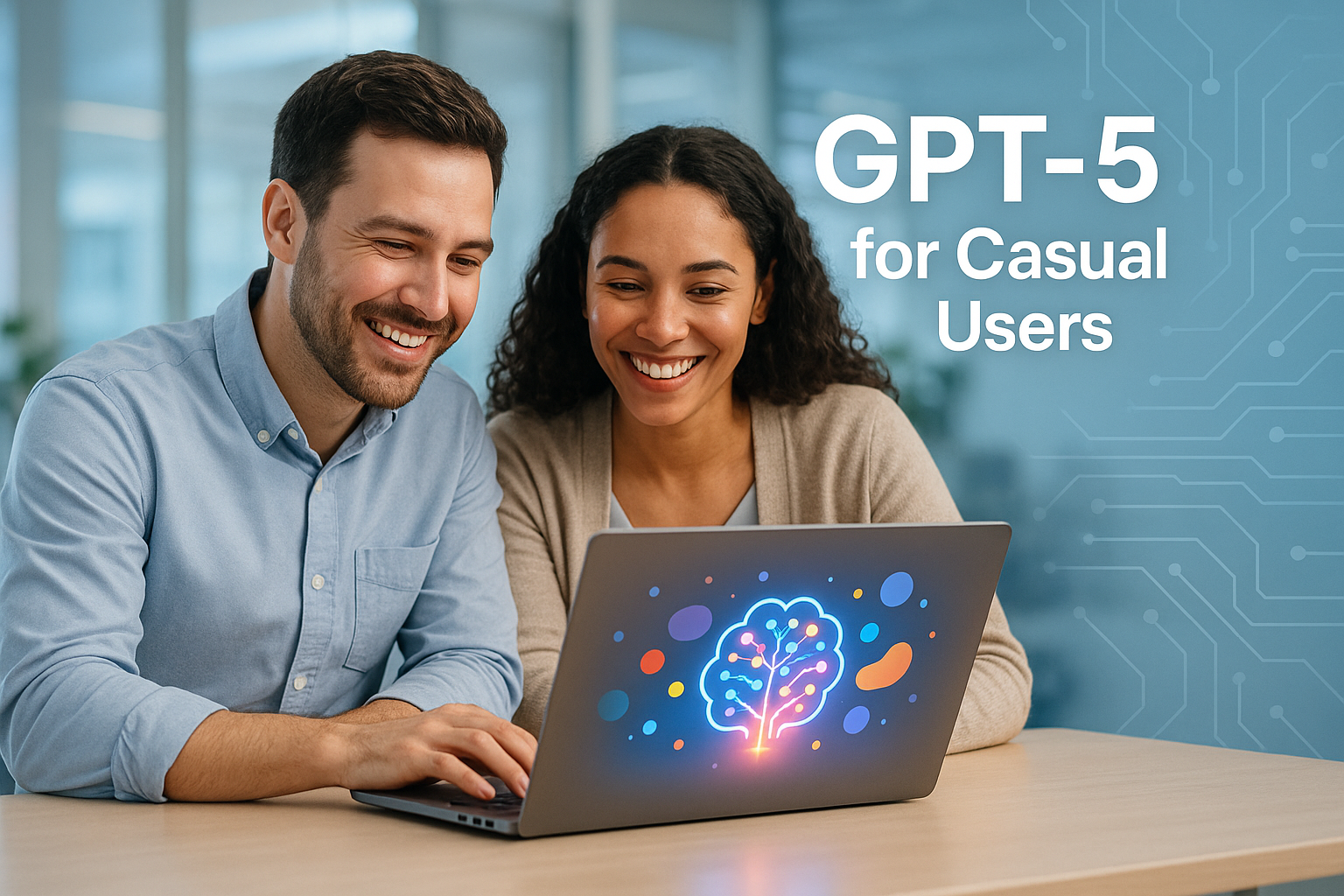Discover how GPT-5’s automatic model routing makes AI simpler, faster, and smarter for everyday users in the USA.
GPT-5 Designed for Casual Users: How Automatic Model Routing Simplifies AI

Artificial intelligence (AI) has evolved rapidly in just a few short years. For most people, keeping up with technical jargon, multiple AI tools, and constant updates feels overwhelming. That’s where GPT-5 for casual users comes in — specifically with its automatic model routing feature.
Instead of forcing you to choose the “right” AI model for every task, GPT-5 does it for you automatically. You simply type your question or request, and the system figures out which version of GPT-5 is best for the job — all without you needing to understand the complex backend.
In this article, we’ll explore how automatic model routing works, why it’s a game-changer for everyday users, and how it’s making AI more accessible, personalized, and effortless for people in the United States.
Why GPT-5 Matters for Everyday Americans
For many U.S. users, AI has already become part of daily life — whether it’s asking Siri for directions, using ChatGPT for homework help, or generating quick email drafts. However, these tools often require some level of technical know-how.
Historically, OpenAI offered multiple models like GPT-3.5, GPT-4, and specialized versions for code, math, or creative writing. The challenge? Most casual users didn’t know which one to choose.
Imagine you’re ordering coffee, but you have to know the exact coffee bean origin, roasting process, and brewing method before placing your order. That’s what picking the right AI model felt like before GPT-5’s automatic routing.
What is Automatic Model Routing?
Automatic model routing is GPT-5’s built-in ability to analyze your request and instantly decide which AI model is best suited for it.
Here’s how it works in simple terms:
- You type your request – e.g., “Explain the causes of the American Civil War in simple language.”
- GPT-5’s system scans your prompt – it detects complexity, topic type, and intent.
- It routes you to the right model – for example, a history-optimized reasoning model for your question.
- You get the best answer without worrying about technical settings.

This means you no longer have to select between different “versions” or “modes.” GPT-5 acts like a smart personal assistant who knows exactly which tool to use in every situation.
Why This Matters for Casual Users
1. No More Confusing Choices
Before, you had to decide: “Do I use GPT-3.5 because it’s faster, or GPT-4 because it’s smarter?” For casual users, that was like asking someone to choose between different car engines when all they want to do is drive.
With automatic routing, the choice is made for you — giving you the perfect balance of speed, accuracy, and creativity without manual input.
2. Faster Responses
Since the system selects the most efficient model for your task, you avoid unnecessary slowdowns. If your question is simple, GPT-5 won’t waste time using a resource-heavy reasoning model. If it’s complex, it will switch to one that can handle deep analysis.
3. Smarter Personalization
Over time, GPT-5 learns your preferences and style. If you like answers that are short and casual, it adjusts. If you tend to request technical details, it leans toward more advanced responses.
Think of it like a Netflix recommendation engine — the more you use it, the better it gets at predicting what you’ll like.
4. Lower Learning Curve
For many Americans who just want AI to “work,” this is the ultimate convenience. No setup. No menus. No frustration. Just results.
Real-Life Examples of GPT-5 Automatic Model Routing in Action
Here’s how different types of U.S. users might experience it:
Students
A high school student writing a book report on To Kill a Mockingbird doesn’t need to pick between AI versions. GPT-5 detects it’s a literature-related task, chooses a model optimized for summarization and interpretation, and delivers a thoughtful answer in plain language.
Small Business Owners
A bakery owner in Chicago wants help writing Instagram captions. GPT-5 routes to its creative content model, providing catchy, friendly posts tailored for local audiences.
Parents
A mom in Texas asks GPT-5 to explain “gravity” to her 8-year-old. The AI selects a model specializing in simple, age-appropriate explanations, making science fun and easy to understand.

Professionals
An architect in New York requests a quick cost estimate for a small renovation project. GPT-5 picks a calculation-friendly model, producing a clear and accurate estimate within seconds.
How Automatic Model Routing Improves AI Accessibility
One of the biggest benefits of GPT-5 for casual users is accessibility.
In tech terms, “accessibility” often means tools are easier to use for people with varying abilities. But here, we’re talking about mental accessibility — removing the intimidation factor from AI.
Automatic model routing:
- Reduces cognitive load – you don’t have to learn tech terms or remember model differences.
- Levels the playing field – even non-tech-savvy users can get expert results.
- Encourages adoption – more people are willing to try AI when it feels effortless.
A Shift in AI User Experience
Before GPT-5, many AI platforms felt like advanced cameras in manual mode — capable of amazing results, but only if you knew how to adjust ISO, shutter speed, and aperture.
GPT-5’s routing system is like switching to auto mode: you focus on the subject, and the camera handles the rest.
For the U.S. market, where consumers value speed, convenience, and minimal hassle, this shift is significant.
Potential Concerns and How They’re Addressed
No technology is perfect, and automatic model routing has its critics. Here are some common concerns — and how GPT-5 tackles them.
1. “What if it picks the wrong model?”
GPT-5 uses advanced intent detection algorithms and continuously learns from user interactions. If it notices you often rephrase questions or request more detail, it adjusts future routing decisions.
2. “Will it hide advanced features from power users?”
Not at all. Casual users get simplicity, while advanced users can still manually select specific models if they prefer full control.
3. “Does it make AI less transparent?”
OpenAI has committed to providing routing details upon request, so users can see which model handled their query and why.
How GPT-5 Compares to Competitors
While some AI tools in 2025, like Anthropic’s Claude and Google’s Gemini, offer multiple models, most still require manual selection.
Perplexity AI, for example, lets users switch between “Quick” and “Pro” modes, but that’s still an extra decision point.
GPT-5’s hands-free model selection sets it apart, especially for non-technical American users who value a smooth, app-like experience.
(Source: OpenAI | Wired Coverage)
Tips for Getting the Most Out of GPT-5 Automatic Model Routing
Even though the system is automatic, you can help it help you:
- Be clear with your request – include specific details when possible.
- Mention your audience – if you want kid-friendly or professional wording, say so.
- Use feedback options – thumbs up or down to improve future routing accuracy.
The Future: AI That Feels Invisible
The long-term vision for GPT-5 and similar AI systems is seamlessness.
In the future, you might not even realize you’re “using AI.” It will be built into your devices, apps, and everyday tools, silently choosing the best methods in the background.
Automatic model routing is a big step toward that future. For casual users, it means AI is finally crossing the bridge from “high-tech gadget” to everyday companion.
Conclusion: Why GPT-5’s Automatic Model Routing is a Game-Changer
For casual users in the United States, GPT-5’s automatic model routing removes the last major barrier to everyday AI use: the complexity of choice.
By handling model selection behind the scenes, it delivers:
- Effortless usability
- Faster, smarter answers
- Personalized interactions
Just like modern cars handle gear shifting for most drivers, GPT-5 lets you focus on the destination, not the mechanics.
As AI becomes more ingrained in American daily life — from classrooms to workplaces to home tasks — tools like GPT-5 will ensure anyone can benefit, regardless of technical skill.
